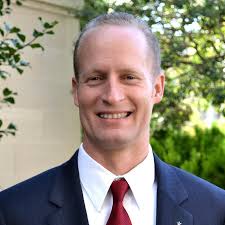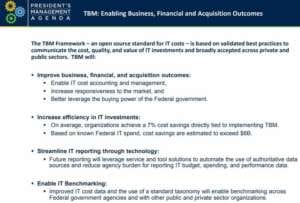
How OMB is moving CIOs from cost center to value add
OMB has created a Technology Business Management (TBM) executive committee and community of interest to promote faster adoption of the framework.
Best listening experience is on Chrome, Firefox or Safari. Subscribe to Ask the CIO’s audio interviews on Apple Podcasts or PodcastOne.
The General Services Administration started down the path using the Technology Business Management (TBM) framework more than two years ago.
David Shive, the chief information officer for GSA, said he began with TBM for purely selfish reasons.
“Based on the fact I was struggling to have good effective conversations about the value of the service I was providing to the businesses of GSA. That was a weakness on my part,” Shive said at a recent panel discussion sponsored by AFFIRM. “The businesses of GSA, the Federal Acquisition Service, the Technology Transformation Service, the Public Buildings Service and a bunch of other smaller partners, they make investment in technology in support of their complex business mission and I suspected that we were doing a good job, making investments through my shop to provide IT for them. But I couldn’t eloquently talk about it. I couldn’t benchmark myself relative to other government agencies or to the private sector.”
Shive began to implement the TBM framework to gain better insights into the value of the IT his office is providing to GSA mission areas. He said in the private sector, CIOs found the conversations moving from IT being a cost center to understanding that IT can make the business run better and transform how the organization serves its customers.

TBM standards let agencies model and manage IT costs and services in order to better direct spending. The TBM framework includes a taxonomy to identify and discuss IT efforts and spending in order for the entire organization to understand.
Shive, and later the Trump administration, wanted that same experience as the private sector.
“There are two main values, and it will be different for every executive responsible for technology or whatever business is running TBM, I’m able to have that value conversation in business terms, not how many cycles, how many MIPs, what’s my network bandwidth is. Instead I’m able to say your transaction times are reduced through the use of technology and that is making you serve your customers better,” he said. “The second value is TBM allows me to use the taxonomy as a decision engine. We do IT here in the federal space, but we are not the only place. The private sector has been doing IT as long as government has and they have established benchmarks on the effective use of technology, effective use of spend for technology and the business outcomes over time. We can take those learnings and say when the private sector makes these kinds of investments, the transition to cloud or dev/sec/ops as a delivery model, they have received good outcomes and it’s likely the government will get the same outcomes.”
Last summer, the Office of Management and Budget asked agencies last to take on TBM as part of its capital planning and investment control (CPIC) process.
Kelly Morrison, a performance analyst at OMB, who also leads the CPIC reform process, said the goal is for TBM is to move the planning process from a static effort to a value-added dynamic one that cuts across the entire agency.
“TBM is a family sport,” Morrison said. “It’s not an IT initiative. It’s also not strictly a finance initiative or acquisition initiative or a human capital initiative, but it’s really bringing the whole family together and not just at one part of the organization, but all parts.”
The administration included TBM as part of the cross-agency priority goals and crosses the three overarching goals of the President’s Management Agenda—IT modernization, data transparency and workforce transformation.
Over the last year, several agencies have been early adopters of TBM and others are just getting started.
Morrison said the impact of TBM became clear over the past year in several ways. She said in late 2016, the incoming administration asked to understand how the $90 billion in technology spending was spread across the agencies and what were they buying. At that point, 84 percent of spending was categorized as “other,” as opposed to being tied to a specific category like help desk or data centers.
Now with only one cycle of TBM, agencies have only 34 percent of their IT spend labeled as uncategorized.
“Agencies have done an incredible job in breaking out their costs,” Morrison said. “But we don’t see this breaking out of costs into TBM elements as TBM implementation. It’s still manual and not coming from authoritative sources. That’s what we really want to change.”
Natalie Rico, a senior policy analyst in the Office of Federal Financial Management, said one agency her office worked with on TBM found it let them move to a capabilities based approach instead of a systems based approach.
“They are finding these systems they didn’t know about and are asking why we have all the same systems that do the same thing instead of having a centralized system,” she said. “There are cost savings, but it isn’t always about cost savings.”
Under the cross-agency goal, Morrison said OMB and the managing agency partners like GSA and the Education Department, are developing ways to ensure agencies can more easily adopt TBM, including a governmentwide strategy and associated playbook.
“We are seeing agencies implementing TBM in different ways and there are different ways to interpret that standard taxonomy,” Morrison said. “So if we are going to adopt TBM governmentwide, we need to think about the approach we are taking and how we do that in a common and consistent way so the outcomes we are enabling will give us the macro benefit of comparing apples-to-apples and will truly benefit the entire federal government and not just individual agencies.”

OMB also has stood up an executive steering committee with CXOs and created a community of practice, which is developing that playbook and created repositories of best practices.
“We really want to see what we can do with data that is available, understand where the gaps are and look at the options that we have to figure out as a broad community with CXO council involvement how we are able to move forward,” Morrison said. “We are hoping not to have to make changes to existing systems. As we engage with different CXO council members, hopefully that will help the change management aspect to get family members on board.”
Morrison said the committee and COI are creating that early stage of governance.
“We wanted to make sure there is an opportunity for agencies to learn and share,” she said. “Now we are at a great point to really start asking the question around what are similarities and differences of implementations and start to figure out how to put a stake in the ground and find the how-to guide for how we will do TBM in a standard and consistent way.”
Copyright © 2024 Federal News Network. All rights reserved. This website is not intended for users located within the European Economic Area.
Jason Miller is executive editor of Federal News Network and directs news coverage on the people, policy and programs of the federal government.
Follow @jmillerWFED






